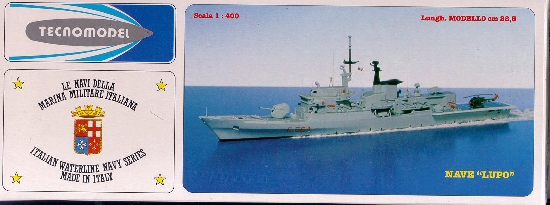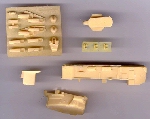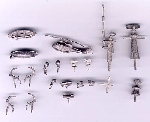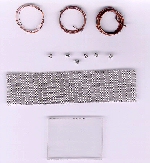 Tecnomodels 1/400 Lupo
There are currently four Lupo Class general-purpose frigates in the Italian Navy that were built in the mid to late 1970s. In addition, four ships were built for Peru and six for Venezuela. Tecnomodels, a Genoa based resin kit manufacturer, has a series of waterline modern Italian Navy ships, of which this is an earlier example. This is a multimedia kit comprised largely of resin and white metal parts, along with some uncommon materials. There are 19 resin parts, which are very well cast and have no pinholes nor overpower. The larger pieces, such as the hull and superstructure components, have a thin casting block that needs to be sanded down. The hull captures the graceful lines of this class of ships with its sharp bow and sweeping forecastle. The openings to the stern work deck need to be opened up with a hobby knife. The smaller resin parts, such as the turrets, missile launchers and anchors need to be removed from a thin casting sheet. Two pairs of the Oto Melara Teseo Mk2 missile launchers are actually cast into the deck that they are mounted on. There are locator holes at various on the resin parts to accommodate the white metal parts. However according to the instructions and looking at the actual pins on the white metal parts, these holes will need to made wider using a drill bit. Holes are also provided for the bitts, which are not cast into the deck. Copper wire, which I will discuss more fully later, is provided for these. The resin parts have a good amount of detail cast into them, such as watertight doors, vertical ladders and anchor chains. Modelers wishing to substitute photoetch version will need to do some sanding. One thing I don't like are the inclined ladders cast into the resin. These are just like the "Aztec steps" that are found on injection-molded kits. If you plan to replace these with photoetch inclined ladders, these will need to be removed and some may prove more difficult to do. The 20 white metal parts include such items as the main and foremasts, gun and missile fire control directors, torpedo tubes, the Augusta-Bell AB 212 helicopter, lifeboats and davits, among other items. The casting of the white metal parts are good but they are not as crisp as the resin parts. Since white metal is a very soft material, the rotors on the helicopter and the upper portion of the main mast came bent in the bag. The mast was easy to fix, but the rotors won't look the same. I am planning to remove the white metal rotors anyhow and replace them with photoetch versions, so this is not a big deal. The radars are cast into the masts as one piece; having photoetch versions of the radars would have been preferred. As a matter of fact, the kit does not come with a photoetch detail set, though other kits in this line do. While the lack of photoetch may be a minus to some modelers, there are other sources for photoetch in 1/400 scale. What are included with this kit are some very untraditional materials for parts. A strip of wire metal mesh is provided to be used as the helicopter pad safety netting, but you must first cut it to the dimensions stipulated in the instructions. Also provided are 3 coils of copper wire in different widths. These are to be used to build the prop guards, boat boom, flag and jack staffs, barrels for the guns, bitts, and whip antennas. Personally, I would discard the mesh for photoetch safety nets and substitute the wire with brass rod. For the whip antennas, small metal bases are provided which is a nice touch. Finally, a piece of clear plastic is provided for the helicopter pad that is to be trimmed down to fit the opening over the lower deck. There is nothing wrong with this; it is just a little unusual based on my experience. The decals provided with the kit are also not traditional, in the sense that they are peel- and-stick and not water transfer. The decals come on three sheets. The first sheet contains the hull and flight deck numbers, markings for the helicopter pad and the ship's name. Another sheet contains black and white strips that appear to be used for the vents and the last sheet contains the helicopter pad markings with the background color. While the decals are generally well done, the middles of the roundels are off-centered. The instructions are completely in Italian, but they are fully illustrated with blow-up diagrams. While the language barrier may present a barrier, especially in terms of the color guide and painting instructions. You can refer to a dictionary or use an online translation utility, like Alta Vista Translations. for assistance While this kit does have some problems, the good points outweigh them in my opinion. There are no modern Italian Navy kits in 1/400 scale (or any scale that I know of), so if you want to add one to you fleet, this is one of your only options. I would recommend this kit to more experienced modelers and I would buy either the general 1/400 scale photoetch sets from Gold Medal Models or L'Arsenal to detail this model. My thanks to Tecnomodels for providing this sample. .
Click on thumbnail for a full-size picture |




